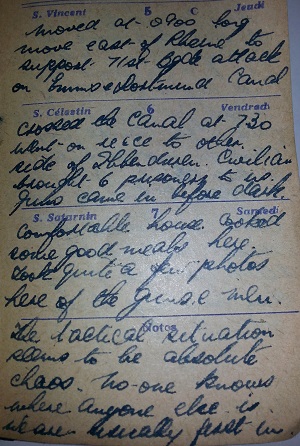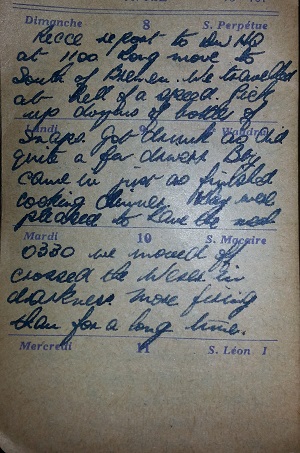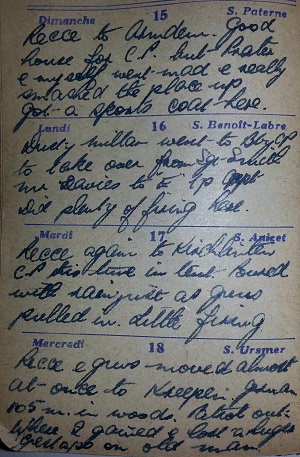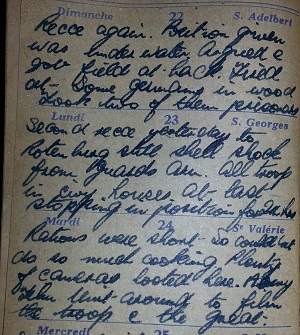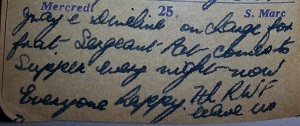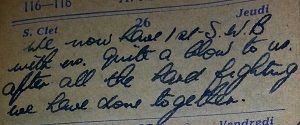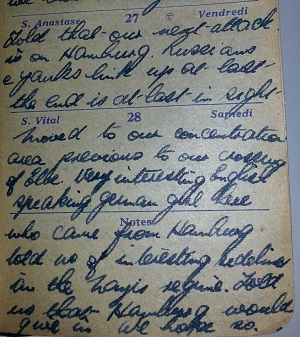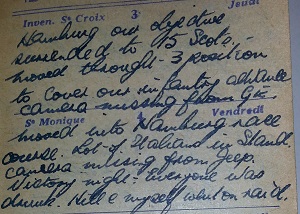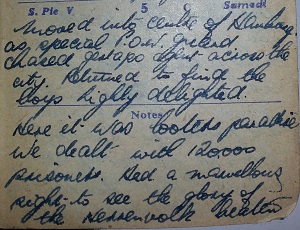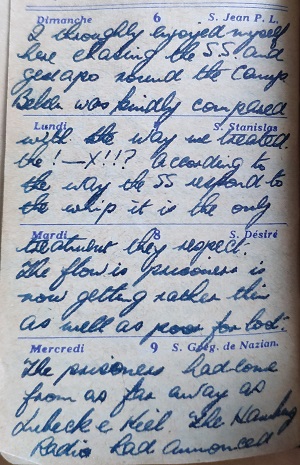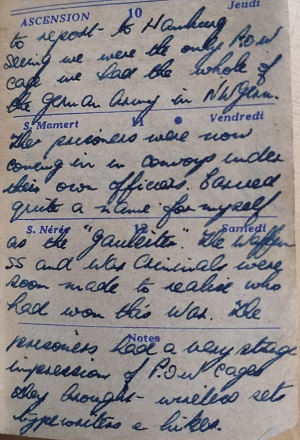Into the Heart of Germany - Victory in the West
(5th April to 7th May 1945)
5th-7th April 1945 - Relieve of Ibbenburen bridgehead
|
Moved at 0900 long move east of Rheine to support 71st Brigade attack on Ems-Dortmund Canal. Crossed the Canal at 730. Went on recce to other side of Ibbenburen. Civilian brought 6 ? to us. Guns came in before dark. Comfortable house. Cooked some good meals here. Took quite a few photos here of the guns & men. The tactical situation seems to be absolute chaos. No-one knows where anyone else is. We are ?. |
It is very interesting that the author describes the situation during these days as 'absolute chaos.'. Also C.N. Barclay points out that the situation was difficult:
"The operations described in this chapter were very fluid. The Division was rarely employed as a whole and Brigades, and sometimes individual units, often operated under other formations. [...]The description corresponds with the diary. In fact the Dortmund-Ems Canal has already been taken by 11th Armoured Division a few days before, but the task of the 53rd Division was to relieve some other units in the Ibbenburen bridgehead:
Plans for the 53rd Division were changed very frequently on the 4th [April 1945] as the situation was extremely fluid, and it was not until 2.30 a.m. on the 5th that the Divisional Operation Order was issued. The 71st Brigade was to proceed to the Divisional concentration area - the area Emsdetten-Mesum-Burgsteinfurt - South of the Ibbenburen bridgehead, and then move into bridgehead to relieve the garrison as early on the 5th April as possible." (Barc56, p.157-158)
"The new role of the [53rd] Division was to relieve the 131st Brigade of the 7th Armoured Division, and later the 155th Brigade of the 52nd (Lowland) Divsion, in the Ibbenburen bridgehead, leaving one Brigade - the 160th - to operate under the 52nd Division in the Rheine Sector." (Barc56, p.158)Also Patrick Delaforce describes the task to relieve the Ibbenburen bridgehead:
"53rd Division were given the task of mopping up the cadets around Ibbenburen supported by 7 RTR Crocodiles and a heavy barrage. At 21.00 hrs [date unknown] 71 Brigade with 1 HLI on the right, 4 RWF on the left advanced over the canal-bridgehead towards the railway line. [...] The Brigade captured 370 prisoners for the loss of only thrity-three casualties." (Dela96, p.190)The following map shows the area between Rheine and the Ibbenbüren bridgehead:
- (Source: Google)
8th-14th April 1945 - Fast move to Bremen, Weser-crossing and Attack on Rethem
|
Recce report to Div. HQ at 1100. Long move to south of Bremen. We travelled at a hell of a speed. Pick up dozens of bottles of snaps. Got drunk as did quite a few ?. ? came in just as finished cooking dinner. They were pleased to have the meal. 0330 we moved off. Crossed the Weser in darkness. More firing than for a long time. |
The description makes it clear that the German resistance began to collapse at this point.
"During the evening of the 7th April orders were received for the [160th] Brigade to move East on the following day and rejoin the 53rd Division. This order was amended at 1.30 p.m. on the 8th and the Brigade ordered to join the 7th Armoured Division at Hoya, on the Weser some 25 miles South of Bremen. [...] The object of these operations was to pave the way for the further advance of the 7th Armoured Division to the Elbe. It was anticipated that the rest of the 53rd Division would follow the 160th Brigade very soon. [...] By daylight on the 8th the Brigade Column had begun its 85 mile move, enlived by the streams of liberated prisoners and Displaced Persons of many nationalities - all moving West. These were exciting times, as it was becoming apparent to all that the war in the West was drawing to its close." (Barc56, p. 162-163)C.N. Barclay also describes the crossing of the Weser by the 83rd Field Regiment and even the time information is an exact match between both descriptions:
"At 9.45 a.m. on the 9th April the 6th R.W.F. [from the 160th Brigade] made an assault crossing [across the river Weser] at Hoya assisted by smoke provided by the 7th Armoured Division. This attack was successful and casualties were light. Bridging began soon and by 11.30 p.m. that night a Class 40 Bailey bridge [across the Weser] had been constructed. [...] The next stage in operations was for the 158th Brigade to pass through the 160th Brigade at Hoya and seize a crossing over the Rhiver Aller about 7 miles to the East. At 11.30 p.m. [probably directly after installation of the Bridge on 9th April] the leading Battalion - the 7th R.W.F. - began crossing the bridge on foot, and quickly occupied Hassel. [...] The 1/5th Welch crossed the bridge at 3.30 a.m. followed at once by the 83rd Field Regiment and Brigade Headquaters." (Barc56, p. 163)Patrick Delaforce confirms the descriptions in his book:
"The bridging [of the Weser] started at noon and a Class 40 Bailey bridge was constructed by midnight. 83rd and 133 Field Artillery Regts plus 72nd Medium Regt were soon in action. 6 RWF lost twenty-one casualties but the river Weser had been crossed with relative ease. So General 'Bobby' Ross ordered 158 Brigade to pass through, and seize a crossing over the river Aller seven miles to the east. The town of Rethem on the west bank was a vital objective.In his book also Major Hughes describes his memories about these days:
7 RWF led, crossed the bridge on foot during the night and quickly occupied Hassel on Tuesday 10 April at 03.00 hrs. [...] Next came 1/5th Welch (and the Brigade gunners, 83rd Field Regt) to begin the ten miles advance to Rethem along sandy tracks, through pine woods across the Hamelheide moor." (Dela96, p. 194-195)
"On the 8th [April 1945] we were ordered to do a long move up though the 7th Armoured Division, and reach the River Weser at Hiltrop. This move was unventful. As we motored through Germany in the warm spring sunshine with young green leaves sprouting on the trees, it seemed strange that the people peering through curtained windows were our enemies. Colonel Brooke and I made up a precautionary fireplan to cover our entry into Hiltrop and a battle plan was drafted. However all was quiet and peaceful, and an unopposed arrivas was our good fortune." (Hugh16, p. 134-135)The following map shows the most important locations in this area:
- (Source: Google)
15th-24th April 1945 - Crossing the River Aller - Heading towards Hamburg
|
Recce to Armsen. Good house for C.P. but ? and myself went mad & really smashed the place up. Got a sports coat here. Dusty Millar went to Bty CP to take over from Sgt Smith. ? Did plenty of firing here. Recce again to Kirchlinteln. C.P. this time in ?. ? with ? just as guns pulled in. Little firing. Recce & guns moved almost at once to Kreepen. German 105mm in woods. Patrol out: Where I gained and lost a luger Gestapo on old man |
|
|
Moved in open ground behind Red Cross village of Kirchwalsede. Trucks were bringing up wounded not knowing we were there. 329 lost some guns. Recce at 0530 this time ? to assist Inf clean up pockets in woods Selsingen. Firing all round the ?. ? 200 eggs. Moved back to last position area ? little forward into a house. Second recce that day. C.P. was now a ? it seemed. plenty of rain again. Everyone getting rather tired of moving up so close to the infantry. Even infantry dont want us so close up. |
|
|
Recce again. Position given was under water. Argued and got field at back. Fired at some Germans in wood. Took two of them prisoners. Second recce yesterday to Rotenburg still shell shock from Guards Arm. All troop in civi houses. At last stopping ? position ?. Rations were short. So could'nt do ? meal cooking. Plenty of cameras looted here. ? around to film the troop & the ?. |
The descriptions during these days are partly hard to read and most of the cited places are bests guesses. Armsen and Kreepen both belong to the town of Kirchlinteln. Therefore these places seem to be reasonable. Kirchlinteln is a town on the eastern side of the River Aller and only a few miles North of Rethem. The map shows the area:
- (Source: Google)
C.N. Barclay gives a good overview, what happend during these days. However, the town of Kirchlinteln is not particularly named in his book:
"During the period 14th to 17th April the 6th R.W.F. (160th Brigade), mounted in 'Kangaroos', were under the 4th Armoured Brigade in a clearing operation beginning at Rethem in the South and moving North to Scharnhorst about 3 miles North-East of Verden. This was an exhilirating experience in what the Battalion described as 'Swanning with the Greys'. They had a hand in the capture of Kirchboitzen, Vethem, Bendingbostel, Scharnhosrt and other villages. Many prisoners were taken.Patrick Delaforce also describes the cooperation between 6th Bn R.W.F. and the 4th Armoured Brigade. He also describes, how these formations meet with 71st Brigade in Kirchlinteln on 17th April:
By the 16th the whole Division was moving North, and on the 17th the 71st Brigade captured Verden - the day on which The Grays and 6th R.W.F. entered Scharnhorst." (Barc56, p. 167)
"The final objective [of the 6RWF with the 4th Armoured Brigade] was the high ground north-east of Verden to link up with 71 Brigade who launched an attack there on the same day [probably on 17th April 1945]. On the way the long armoured column wound its way through the gaps in the woods and overwhelmed several groups of enemy, a battery of horsedrawn 105 mm and some isolated 88 mm guns. Contact was made at Kirchlinten at mid-day with 71 Brigade." (Dela96, p. 206)
25th-26th April 1945 - Leave of 7th RWF
| ? on charge for ?. Sergeant ? comes to supper every night now. Everyone happy. 7th RWF leave us. | |
| We now have 1st S.W.B. with us. Quite a blow to us after all the hard fighting we have done together. |
The description in the diary show the impact of the departure of the 7th Battalion R.W.F.. The event is also described by C.N. Barclay and Patrick Delaforce.
"On this day the 2nd Bn The South Wales Borderers joined the Division (158th Brigade) from the 49th Division and the 7th R.W.F. left to take their place in the 49th. However good the reasons for changes of this kind may be they are rarely popular with the units concerned. For the Welsh Division it was sad to lose the 7th Royal Welch Fusiliers who had fought so gallantly since the early days in the Normandy beachhead." (Barc56, p. 170)
"Even at this late stage young recruits were pouring in to replace the losses incurred since the Rhine crossing. But two particularly sad events now occured. [...] And secondly 7 RWF learned that it was to leave 53 Welsh Division and join the 56 Brigade of 49 Polar Bear Division. General 'Bobby' Ross came to say goodbye to 7 RWF which moved off on the 27th [April 1945] to the Arnhem area - with heavy hearts. And 2nd Battalion South Wales Borderers joined the Division from the Polar Bears." (Dela96, p. 211-212)Only the information given on the Battalion of the South Wales Borderers described in the diary (1st Battalion S.W.B.) does not fit with literature (2nd Battalion S.W.B.)
27th April - 4th May 1945 - Hamburg - Victory Night
|
Told that our next attack is on Hamburg. Russians and Yanks link up at last. The end is at last in sight. Moved to our cenentration area previous to our crossing of Elbe. Very interesting English speaking german girl here who came from Hamburg told us of interesting sideline in the Nazis regime. Told us that Hamburg would give in. We hope so. |
|
|
Still here in the concentration area. Had some practice with my .22. Boys were wondering if we would all survive this next attack. Recce to RHQ 1100 hours. long move through Luneburg quite large place. Crossed Elbe. Big river. Position very open. yesterday position was near a ammo works. Got 5000 .22. Recce position at Geesthacht. C.P. in a large house. Troop on a ? of a hill. This is where I got a pistol off a police official. C.P. seemed to be a block of flats. Got camera from Italian. |
|
|
Hamburg our objective surrendered to 15 Scots. Moved through 3 Position to cover our infantry advance. camera missing from GE Moved into Hamburg race course Lot of Italians in ?. camera missing from Jeep. Victory night: Everyone was drunk. ? & myself went on raid. |
It is intersting to note that the descriptions in the diary as well as in literature become less detailed durig these days.
This is probably due to the multitude of events and the fact that the war was now coming to an end.
The town of Geesthacht is not mentioned in literature, but it fits to the descriptions by C.N. Barclay, that indicate that the 53rd Division crossed the Elbe to the South East of Hamburg:
"The Division was no to move piecemeal to the Elbe. On the night of the 29/30th April the 160th Brigade relieved part of the 11th Armoured Division on the Elbe about Winsen." (Barc56, p. 170)Winsen lies at the south bank of the Elbe a bit south east of Geesthacht, which lies on the north bank of the Elbe. The following map shows both towns:
- (Source: Google)
Also the surrender and the subsequent occupation of Hamburg is described by C.N. Barclay:
"The 15th (Scottish) Division had carried out an assault crossing of the elbe on the 29th April and on the 2nd May the Division began passing through the bridgehead. On the 3rd the Germans surrendered Hamburg and declared it an open City. The population had been ordered to remain indoors. The 7th Armoured Division had already entered Hamburg and the 53rd (Welsh) Division was ordered to relieve it and assume responsibility for the town.
At dawn on the 4th May 1945 the 53rd (Welsh) Division began to enter Germany's largest Port and second City. The entry occupation were without incident and by breakfast time troops of the Division were on the bridge over the Alster in the heart of the City. The heavily-bombed town presented a gaunt appearance. The only Germans to be seen were the Civil Police who were posted at intervals of about 100 yards on either side of the road.
This was the end.
Hitler and Mussolini were dead.
On the 1st May troops of the British 21st Army Group had joined up with Russian troops between Lubeck and Rostock.
On the 2nd May Marshal Zhukov's Second White Russian Army Group entered Berlin, and on the same day all German forces in Italy surrendered to Field Marshal Sir Harold Alexander.
On the 4th May all enemy forces in North Germany were surrendered to Field-Marshal Sir Bernard Montgomery at his Tactical Headquaters on Luneburg Heath.
On the 7th May 1945 all German Forces by sea, land and air surrendered unconditionally to the Allies." (Barc56, p. 170-171)
5th-14th May 1945 - Guarding P.O.W. camp
|
Moved into centre of Hamburg as special P.O.W. guard. chased Gestapo agent across the city. Returned to find the boys highly delighted. Here it was looters paradise. We delt with 120,000 prisoners. Had a marvellous sight to see the glory of the Herrenvolk beaten. |
|
|
I thoroughly enjoyed myself here chasing the SS and Gestapo round the camp. Belsen was kindly compared with the way we treated the !-X!!?
According to the way the SS respond to the whip it is the only treatment they respect. The flow of prisoners is now getting rather thin as well as poor for loot. The prisoners had come from as far away as Lübeck & Kiel. |
|
|
The Hamburg Radio had anounced to rerport to Hamburg seeing we were the only P.O.W. camp we had the whole of the German Army in NW Germ. The prisoners were now coming in in convoys under their own officers. Earned quite a name for myself as the "Gauleiter". The Waffen SS and War criminals were soon made to realise who had won this war. The prisoners had a very strange impression of P.O.W. ?. They brought wireless sets, typewriters and bikes. |
|
| Had quite a collection of women in. Mostly belonged to the Luftwaffe. Did 24 hours on and 24 hours off on this job. Very glad to be on this and not with the battery. Really a good job. No parades ?. |
The descriptions in the diary clearly show how the tension is released from the author. It certainly must have been a great feeling to know, that greatest dangers were over
and to be on the winning side.
C.N. Barclay also describes the occupational duties of the 53rd Division:
"As explained [...] the end of hostilities found the Welsh Division on the Elbe, in and around Hamburg. The Division was immediately given the task of garrisoning the City and its suburbs; [...] During the first few days many Prisoners of War and Displaced Persons' Camps were discovered and all units were fully engaged in the problems which this involved. Of the two categories of personnel Displaced Persons proved by far the more difficult to deal with. Some, mostly Poles, did not wish to return to their home country, whilst large numbers of all nationalities converged on Hamburg from outlying districts. On the whole law and order was well maintainedin the City, but constant vigilance was necessary to prevent looting and raids on food stores. [...] On the 18th May the evacuation of Prisoners of War began. [...] By the 27th May conditions in Hamburg had improved sufficiently to permit some relaxation of the curfew, which from that date operated from 9.15 p.m. to 5 a.m. As in other countries Germany had its 'black market' and, in the early days, it was part of the troops' duties to assist in its suppression." (Barc56, p. 185-186)I wanted primarily to document the events up to the end of the war. Therefore I stop at this point with the transcription of the diary. There are also entries for the rest of 1945, but these are becoming increasingly rare and less coherent.
